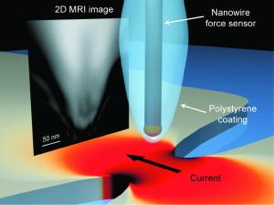Home > Press > A new paradigm for nanoscale resolution MRI has been experimentally achieved
 |
| Illustration of the experimental setup shows the two unique components of the teams novel MRI technique that was successful in producing a 2D MRI image with spatial resolution on the nanoscale. |
Abstract:
A team from the University of Illinois at Urbana-Champaign and Northwestern University has devised a novel nuclear magnetic resonance imaging (MRI) technique that delivers a roughly 10nanometer spatial resolution. This represents a significant advance in MRI sensitivity—modern MRI techniques commonly used in medical imaging yield spatial resolutions on the millimeter length scale, with the highest-resolution experimental instruments giving spatial resolution of a few micrometers.
A new paradigm for nanoscale resolution MRI has been experimentally achieved
Urbana, IL | Posted on September 28th, 2013"This is a very promising experimental result," said U. of I. physicist Raffi Budakian, who led the research effort. "Our approach brings MRI one step closer in its eventual progress toward atomic-scale imaging."
MRI is used widely in clinical practice to distinguish pathologic tissue from normal tissue. It is noninvasive and harmless to the patient, using strong magnetic fields and non-ionizing electromagnetic fields in the radio frequency range, unlike CT scans and tradiational X-rays, which both use more harmful ionizing radiation.
MRI uses static and time-dependent magnetic fields to detect the collective response of large ensembles of nuclear spins from molecules localized within millimeter-scale volumes in the body. Increasing the detection resolution from the millimeter to nanometer range would be a technological dream come true.
The team's breakthrough—the new technique introduces two unique components to overcome obstacles to applying classic pulsed magnetic resonance techniques in nanoscale systems. First, a novel protocol for spin manipulation applies periodic radio-frequency magnetic field pulses to encode temporal correlations in the statistical polarization of nuclear spins in the sample. Second, a nanoscale metal constriction focuses current, generating intense magnetic field-pulses.
In their proof-of-principal demonstration, the team used an ultrasensitive magnetic resonance sensor based on a silicon nanowire oscillator to reconstruct a two-dimensional projection image of the proton density in a polystyrene sample at nanoscale spatial resolution.
"We expect this new technique to become a paradigm for nanoscale magnetic-resonance imaging and spectroscopy into the future," added Budakian. "It is compatible with and can be incorporated into existing conventional MRI technologies."
####
For more information, please click here
Contacts:
Raffi Budakian
Department of Physics
217-333-3065
Siv Schwink
Department of Physics
217/552-5671
Copyright © University of Illinois College of Engineering
If you have a comment, please Contact us.Issuers of news releases, not 7th Wave, Inc. or Nanotechnology Now, are solely responsible for the accuracy of the content.
| Related Links |
| Related News Press |
News and information
![]() Simulating magnetization in a Heisenberg quantum spin chain April 5th, 2024
Simulating magnetization in a Heisenberg quantum spin chain April 5th, 2024
![]() NRL charters Navy’s quantum inertial navigation path to reduce drift April 5th, 2024
NRL charters Navy’s quantum inertial navigation path to reduce drift April 5th, 2024
![]() Discovery points path to flash-like memory for storing qubits: Rice find could hasten development of nonvolatile quantum memory April 5th, 2024
Discovery points path to flash-like memory for storing qubits: Rice find could hasten development of nonvolatile quantum memory April 5th, 2024
Imaging
![]() Nanoscale CL thermometry with lanthanide-doped heavy-metal oxide in TEM March 8th, 2024
Nanoscale CL thermometry with lanthanide-doped heavy-metal oxide in TEM March 8th, 2024
![]() The USTC realizes In situ electron paramagnetic resonance spectroscopy using single nanodiamond sensors November 3rd, 2023
The USTC realizes In situ electron paramagnetic resonance spectroscopy using single nanodiamond sensors November 3rd, 2023
![]() Observation of left and right at nanoscale with optical force October 6th, 2023
Observation of left and right at nanoscale with optical force October 6th, 2023
Discoveries
![]() Chemical reactions can scramble quantum information as well as black holes April 5th, 2024
Chemical reactions can scramble quantum information as well as black holes April 5th, 2024
![]() New micromaterial releases nanoparticles that selectively destroy cancer cells April 5th, 2024
New micromaterial releases nanoparticles that selectively destroy cancer cells April 5th, 2024
![]() Utilizing palladium for addressing contact issues of buried oxide thin film transistors April 5th, 2024
Utilizing palladium for addressing contact issues of buried oxide thin film transistors April 5th, 2024
Announcements
![]() NRL charters Navy’s quantum inertial navigation path to reduce drift April 5th, 2024
NRL charters Navy’s quantum inertial navigation path to reduce drift April 5th, 2024
![]() Discovery points path to flash-like memory for storing qubits: Rice find could hasten development of nonvolatile quantum memory April 5th, 2024
Discovery points path to flash-like memory for storing qubits: Rice find could hasten development of nonvolatile quantum memory April 5th, 2024
Interviews/Book Reviews/Essays/Reports/Podcasts/Journals/White papers/Posters
![]() Simulating magnetization in a Heisenberg quantum spin chain April 5th, 2024
Simulating magnetization in a Heisenberg quantum spin chain April 5th, 2024
![]() Discovery points path to flash-like memory for storing qubits: Rice find could hasten development of nonvolatile quantum memory April 5th, 2024
Discovery points path to flash-like memory for storing qubits: Rice find could hasten development of nonvolatile quantum memory April 5th, 2024
Tools
![]() Ferroelectrically modulate the Fermi level of graphene oxide to enhance SERS response November 3rd, 2023
Ferroelectrically modulate the Fermi level of graphene oxide to enhance SERS response November 3rd, 2023
![]() The USTC realizes In situ electron paramagnetic resonance spectroscopy using single nanodiamond sensors November 3rd, 2023
The USTC realizes In situ electron paramagnetic resonance spectroscopy using single nanodiamond sensors November 3rd, 2023
|
|
||
|
|
||
| The latest news from around the world, FREE | ||
|
|
||
|
|
||
| Premium Products | ||
|
|
||
|
Only the news you want to read!
Learn More |
||
|
|
||
|
Full-service, expert consulting
Learn More |
||
|
|
||








